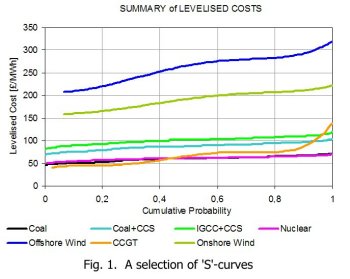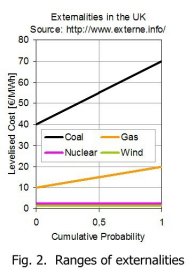Colin Gibson: A Probabilistic Approach to Levelised Cost for Various Types of Electricity Generation, published by The Institution of Engineers and Shipbuilders in Scotland (IESIS), October 2011.
All governments are in favour of a green and safe future energy supply based on renewable energy sources. The additional cost of a transition into green energy is usually played down and supposed to be offset by saved external costs and more indirect benefits. Only little real information is available on the cost of electricity production. Therefore the public debate is based more on faith than on facts.
Colin Gibson has collected data for a wide range of production technologies and arranged it in a probabilistic framework. The result is an 'S'-curve for each technology. An 'S'-curve is a cumulative probability. In the words of the author: "A point on the S-Curve represents the probability that that cost will be less than this value.", and "The levelised cost of a type of generation is taken as all the costs as seen by the customer discounted with regard to time, divided by the energy output also discounted with regard to time."

A steep curve indicates a more uncertain price than a flat curve.
The CCGT curve in fig. 1 reflects the uncertainty of the future gas prices.
It is remarkable that levelised costs of energy from nuclear plants and traditional coal fired units are within the same range. The variations of wind energy costs mostly reflect variations in capital costs and in load factors.
The work of Colin Gibson is a welcome initiative aiming at better public access to realistic information on the cost of electricity production to the consumers. Hopefully the work will encourage further studies and analyses and a public debate based on real data.
The method
For each technology the energy cost depends on a number of parameters, with the central estimates for each parameter being collected from a number of sources. The key variables are the input parameters to which the levelised cost was determined to be most sensitive. High and low values were selected for the key variables and probabilities assigned to each of these values. The method assumes the key variables to be stochastically independent.
An ordered list of levelised costs and probabilities was set up and cumulated probabilities calculated.
The report explains in detail the selection of parameters for each technology and the sources of data, and the author recognizes the need for better empirical data, particularly regarding probabilities. Indeed, he hopes to provoke a debate to draw out the best engineering judgment regarding these input parameters.
A spreadsheet with data and macros for the calculations is published together with the report, providing an opportunity for interested readers to test other data and to present qualified contributions.
Can external effects justify wind power?
 Conversion of energy has an environmental impact. Use of fossil energy causes emission of green house gases (GNG), and some pollutants.
Conversion of energy has an environmental impact. Use of fossil energy causes emission of green house gases (GNG), and some pollutants.
The EU project ExternE has assessed the economic aspects of global warming effects, health effects on the public and personnel, physical damage, etc., and estimated a cost per kWh (http://www.externe.info/).
For comparison the ranges of externalities for the UK are shown in fig. 2. Please note that while cost in fig. 1 is £/MWh it is €/MWh in fig. 2.
Fig. 2 is intended to indicate magnitudes only. The curves are straight lines for want of something better.
Taken literally the externalities tend to eliminate differences between different fossil fuel technologies but they cannot justify the additional cost of wind energy.
Other data or arguments seem to be required for a justification of large investments in wind power.
Limitations of the probabilistic approach
If the probabilistic data has approximately the same quality as the central estimates the probabilistic approach will be a significant step forward. Otherwise, the probabilistic approach cannot provide much more useful information than the central estimates.
It may be argued that nuclear externalities should be assessed differently after the Fukushima incident. However, the impact of nuclear incidents cannot be estimated reliably by probabilistic methods because a sufficient database cannot be established, and scenario planning is a more appropriate tool for dealing with very unlikely events with very serious consequences, and the conclusions must depend on strategic or political considerations.
Better data might prevent manipulated results
It is in the public interest to be able to understand the background of decisions in relation to large energy investments, but energy matters are complicated because climate effects, security of supply and other risks must be considered together. The quality of publicly available data on energy costs for alternative technologies is one important piece of the puzzle.
While the probabilistic approach adopted by Mr. Gibson is a step forward, it is not without its own risks. When only roughly estimated data is available for probabilistic planning and for the calculation of the cost of external effects there is, unfortunately, the possibility that the analyst may promote certain solutions by choosing optimistic or pessimistic parameter values and probabilities. The bias is not necessarily deliberate, but may be the result of wishful thinking, and is very difficult to avoid.
Consequently, a large collection of empirical cost data is necessary in order to establish reliable central estimates and distribution functions for the key variables, a point which underlines the extreme importance of the systematic collection and publication of cost data on electricity production.
But the effort would be worthwhile. Colin Gibson's work is important, and deserves both recognition and constructive engagement.
There are links to the report and the spreadsheet at the IESIS' web site:
Colin Gibson is formerly Power Network Director with the National Grid.
Recent reports on electricity production costs in the UK and US
-- Parsons Brinckerhoff, 2011: Electricity Generation Cost Model - 2011 Update - Revision 1
-- Arup, 2011: Review of the generation costs and deployment potential of renewable electricity technologies in the UK
-- Mott McDonald, 2010: UK Electricity Generation Costs Update
-- US Energy Information Administration, 2011: Levelized Cost of New Generation Resources
in the Annual Energy Outlook 2011